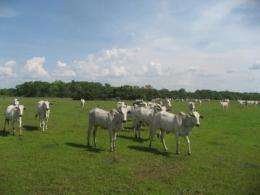Grazing as a conservation tool

Rotational grazing of cattle in native pasturelands in Brazil's Pantanal and Cerrado regions can benefit both cattle and wildlife, according to a new study by the Wildlife Conservation Society.
The technique, which has been adapted for a variety of livestock worldwide, calls for cattle to graze in small areas for shorter periods of time before moving onto other pastures. The result is a greater forage base that produces larger, more valuable cattle while reducing incentives for deforestation, uncontrolled burning, and replacement of native vegetation with exotic grasses.
The study appears in the March 2011 edition of Mongabay.com's open access journal: Tropical Conservation Science. Authors of the study include: Donald Parsons Eaton, José Vergílio Bernardes Lima and Alexine Keuroghlian of the Wildlife Conservation Society; Sandra Aparecida Santos of Empresa Brasileira de Pesquisa Agropecuária; and Maria do Carmo Andrade Santos of WCS and Universidade Federal de Mato Grosso do Sul.
The study showed that the forage base of native grasses was greater in areas that were rotationally grazed and produced cattle that were 15 percent heavier with 22 percent higher pregnancy rates.
"The results of this study show a potential win-win situation for the Pantanal and Cerrado's ranches and wildlife," said the study's lead author, Donald Parsons Eaton of the Wildlife Conservation Society. "Using rotational grazing techniques will produce healthier cattle for ranchers and help safeguard wildlife that call home to this incredibly biodiverse region."
The Pantanal and Cerrado regions are home to jaguars, peccaries, giant anteaters, and 740 species of birds. The region was recently profiled in a new WCS field guide, Birds of Brazil, which documented its rich bird life and drew attention to the threats these regions face from agribusiness and overdevelopment.
Many areas of the Pantanal and Cerrado have already been converted to large scale non-sustainable ranching operations, where native forests and savannas were replaced by exotic grasses. While these techniques sometimes produce higher profits in the short term, they leave behind an impoverished, deforested landscape prone to erosion and drought, threatening wildlife conservation, cattle health, and herd production.
"The timing of this study couldn't have been much better," said Mariana Varese, WCS acting director for Latin America and Caribbean Program. "We look forward to working with Brazil's ranching community to apply the results of this study for the benefit of wildlife and ranchers."
Provided by Wildlife Conservation Society















